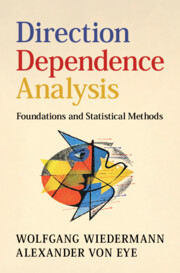Book contents
- Direction Dependence Analysis
- Direction Dependence Analysis
- Copyright page
- Contents
- Preface
- Chapter 1 Introduction
- Chapter 2 The Linear Regression Model
- Chapter 3 Asymmetry Properties of Distributions of Observed Variables
- Chapter 4 Asymmetry Properties of Error Distributions
- Chapter 5 Independence Properties of Causes and Errors
- Chapter 6 Direction of Dependence under Latent Confounding
- Chapter 7 The Integrated Framework of Direction Dependence Analysis
- Chapter 8 Stability and Sensitivity Analyses
- Chapter 9 Extensions and Applications
- Chapter 10 Statistical Software
- Chapter 11 Concluding Remarks
- References
- Index
Chapter 7 - The Integrated Framework of Direction Dependence Analysis
Published online by Cambridge University Press: 16 September 2025
- Direction Dependence Analysis
- Direction Dependence Analysis
- Copyright page
- Contents
- Preface
- Chapter 1 Introduction
- Chapter 2 The Linear Regression Model
- Chapter 3 Asymmetry Properties of Distributions of Observed Variables
- Chapter 4 Asymmetry Properties of Error Distributions
- Chapter 5 Independence Properties of Causes and Errors
- Chapter 6 Direction of Dependence under Latent Confounding
- Chapter 7 The Integrated Framework of Direction Dependence Analysis
- Chapter 8 Stability and Sensitivity Analyses
- Chapter 9 Extensions and Applications
- Chapter 10 Statistical Software
- Chapter 11 Concluding Remarks
- References
- Index
Summary
Chapter 7 integrates direction of dependence properties of variable distributions, error distributions, and predictor–error independence patterns into a cohesive framework. The resulting framework involves six distinct steps, and enables researchers to empirically test hypotheses of causation and derive statements about the direction of the underlying causal mechanism that generates the observed variable association. Furthermore, the chapter discusses principles of covariate selection in modeling the direction of dependence. These principles can serve as the basis for identifying eligible and rule out non-eligible covariates, that is, empirically distinguishing between confounders (common causes which should be adjusted for) and colliders (common effects which should not be adjusted for to avoid biased conclusions). In addition, we provide an exposition of the assumptions necessary to perform Direction Dependence Analysis (DDA) and discuss potential remedies in cases of assumption violations. The chapter concludes with an illustration of the steps taken in DDA using a real-world data example.
Keywords
Information
- Type
- Chapter
- Information
- Direction Dependence AnalysisFoundations and Statistical Methods, pp. 206 - 236Publisher: Cambridge University PressPrint publication year: 2025
Accessibility standard: WCAG 2.2 AAA
Why this information is here
This section outlines the accessibility features of this content - including support for screen readers, full keyboard navigation and high-contrast display options. This may not be relevant for you.Accessibility Information
Content Navigation
Allows you to navigate directly to chapters, sections, or non‐text items through a linked table of contents, reducing the need for extensive scrolling.
Provides an interactive index, letting you go straight to where a term or subject appears in the text without manual searching.
Reading Order & Textual Equivalents
You will encounter all content (including footnotes, captions, etc.) in a clear, sequential flow, making it easier to follow with assistive tools like screen readers.
You get concise descriptions (for images, charts, or media clips), ensuring you do not miss crucial information when visual or audio elements are not accessible.
You get more than just short alt text: you have comprehensive text equivalents, transcripts, captions, or audio descriptions for substantial non‐text content, which is especially helpful for complex visuals or multimedia.
Visual Accessibility
You will still understand key ideas or prompts without relying solely on colour, which is especially helpful if you have colour vision deficiencies.
You benefit from high‐contrast text, which improves legibility if you have low vision or if you are reading in less‐than‐ideal lighting conditions.
